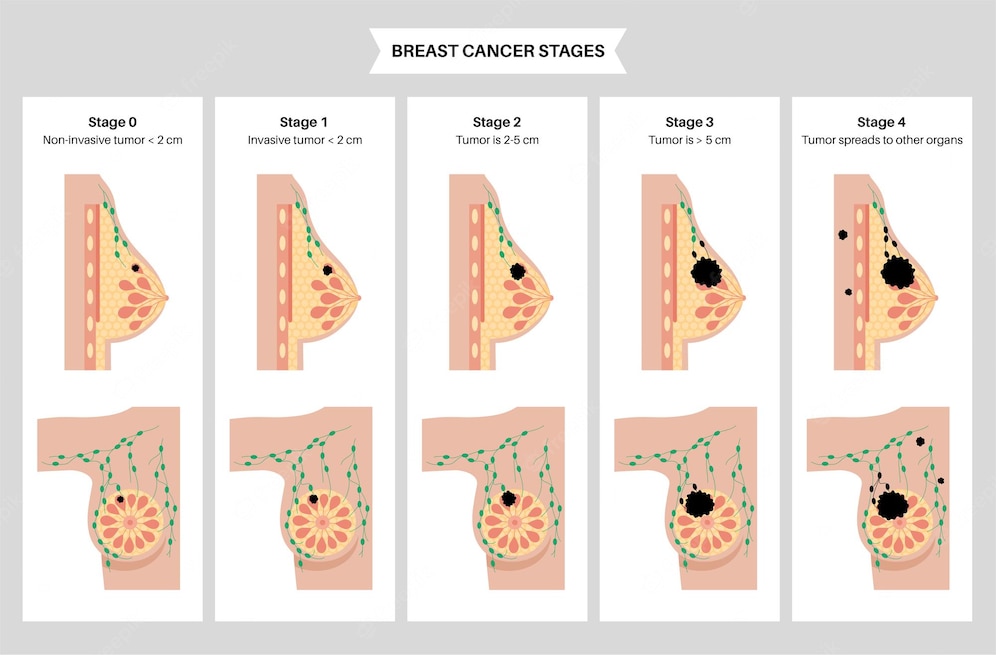WHAT IS CANCER?
Generally, normal cells multiply leading to an increase in the number of cells. To counter that, cells die naturally, thus maintaining a cycle of cell multiplication and cell death. Sometimes, under the influence of certain agents (carcinogenic agents), certain cells start multiplying beyond the normal rate. Such aggressive, uncontrolled growth of cells in the breast is known as breast cancer.
When this growth is confined within the breast duct or breast lobule it is called a breast tumour.
When the growth breaks through the boundaries, and invades into adjacent tissues or spreads to other parts of the body, it is termed as breast cancer.

TYPES OF BREAST CANCER
- a. Ductal - It is the cancer that begins in the cells that line the breast duct. When it is confined within the ducts, it is called as ductal carcinoma in-situ (DCIS). In this stage, cancers can be detected by mammogram and can be cured successfully. If the tumour breaks/ crosses the ductal lining, it may spread to other parts of the body.
- b. Lobular - It is the cancer that begins in the lobule of the breast. [When it is confined within the lobules, it is called as lobular carcinoma in-situ (LCIS).]
SIGNS AND SYMPTOMS
It is important for every person to know the signs and symptoms of breast cancer, and if any time an abnormality is discovered, it should be investigated by a health care professional immediately. Ideally, you should get yourself checked every year by a doctor, and get an ultrasound or mammography done after 40 years of age.
WHAT ARE THE STAGES OF BREAST CANCER?
There are five stages of breast cancer, starting from stage 0. These stages are categorized based on size of the lesion, the involvement of axillary lymph nodes and the extent of spread of the lesion.
WHAT ARE THE STAGES OF BREAST CANCER?
There are five stages of breast cancer, starting from stage 0. These stages are categorized based on size of the lesion, the involvement of axillary lymph nodes and the extent of spread of the lesion.
- Stage 0: This is the pre-cancerous stage, where the tumour is within the duct, and the walls of the duct do not allow the tumour to spread. The astonishing fact about stage 0 is that it may even last for 8 years before turning malignant or harmful. This stage can be detected with mammogram and ultrasound.
- Stage 1: The tumour size in this stage is less than 2 cms.
- Stage 2a: The tumour size in more than 2 cms but less than 5 cms.
- Stage 2b: The tumour in this stage involves the axillary lymph node.
- Stage 3: This is an advanced breast cancer stage, where the tumour is greater than 5 cms and involves multiple axillary lymph nodes, stuck together to form a mass.
- Stage 4: This is the last stage where the tumour spreads to the rest of the body such as lungs, liver, bones, etc.
It is therefore essential to diagnose breast cancer in stage 0 or 1, so that it can be completely cured and the woman can lead a normal, fruitful life.
RISK FACTORS
There are five stages of breast cancer, starting from stage 0. These stages are categorized based on size of the lesion, the involvement of axillary lymph nodes and the extent of spread of the lesion.
WHO CAN GET CANCER?
While the prevalence of breast cancer is alarming and its stages dreadful, what are the chances of developing breast cancer? These changes depend on a combination of our genes, lifestyle and surrounding environment.
There are two types of risk factors that increase our chances of having breast cancer: non-modifiable and modifiable.
However, having a risk factor does not mean a woman will definitely suffer from breast cancer. It only means the chances of her getting breast cancer are higher than the others.
Now that you know what can amount to breast cancer risk, how do you prevent it? Steps you can take to modify your lifestyle


